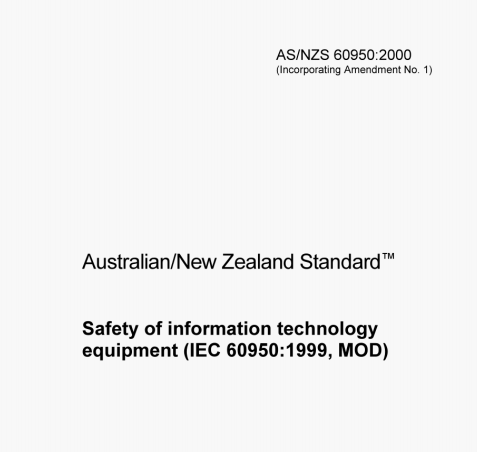AS/NZS 60950:2000 pdf – Safety of information technology equipment (IEC 60950:1999, MOD).
Examples of measures to reduce such hazards include:
— providing overcurrent protection;
— using constructional materials having appropriate flammability properties for their purpose:
— selection of parts, components and consumable materials to avoid high temperature which might cause ignition;
— limiting the quantity of combustible materials used;
— shielding or separating combustible materials from likely ignition sources;
— using ENCLOSURES or barriers to limit the spread of fire within the equipment;
— using suitable materials for ENCLOSuRES SO as to reduce the likelihood of fire spreading from the equipment.
0.2.4 Heat related hazards
Hazards may result from high temperatures under normal operating conditions, causing:
— burns due to contact with hot accessible parts;
— degradation of insulation and of safety-critical components;
— ignition of flammable liquids.
Examples of measures to reduce such hazards include:
— taking steps to avoid high temperature of accessible parts;
— avoiding temperatures above the ignition point of liquids;
— provision of markings to warn USERS where access to hot parts is unavoidable.
0.2.5 Mechanical hazards Hazards may result from:
— sharp edges and corners;
— moving parts which have the potential to cause injury:
— equipment instability;
— flying particles from imploding cathode ray tubes and exploding high pressure lamps Examples of measures to reduce such hazards include:
— rounding of sharp edges and corners:
— guarding;
— provision of SAFETY INTERLOCKS;
— providing sufficient stability to free-standing equipment;
— selecting cathode ray tubes and high pressure lamps that are resistant to implosion and explosion respectively;
— provision of markings to warn USERS where access is unavoidable.
0.2.6 RadiatIon
Hazards to USERS and to SERVICE PERSONNEL may result from some forms of radiation emitted by equipment. Examples are sonic (acoustic), radio frequency, infra-red, ultraviolet and ionizing radiation, and high intensity visible and coherent light (lasers).
Examples of measures to reduce such hazards include:
— limiting the energy level of potential radiation sources;
— screening radiation sources;
— provision of SAFETY INTERLOCKS;
— provision of markings to warn USERS where exposure to the radiation hazard is unavoidable.
0.2.7 ChemIcal hazards
Hazards may result from contact with some chemicals or from inhalation of their vapours and
fumes.
Examples of measures to reduce such hazards include:
— avoiding the use of constructional and consumable materials likely to cause injury by contact or inhalation during intended and normal conditions of use;
— avoiding conditions likely to cause leakage or vaporization;
— provision of markings to warn USERS about the hazards.
0.3 MaterIals and components
Materials and components used in the construction of equipment should be so selected and arranged that they can be expected to perform in a reliable manner for the anticipated life of the equipment without creating a hazard, and would not contribute significantly to the development of a serious fire hazard Components should be selected so that they remain within their manufacturers’ ratings under normal operating conditions, and do not create a hazard under fault conditions.
AS/NZS 60950:2000 pdf – Safety of information technology equipment (IEC 60950:1999, MOD)
